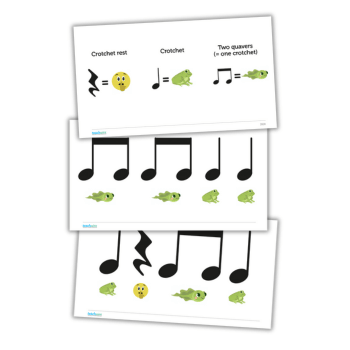Use these frog and tadpole-themed note lengths cards to teach pupils about crotchet rests, crotchets and quavers.
The number of syllables in the words ‘frog’ and ‘tadpole’ will help pupils to remember the note lengths. Find teaching ideas for using the cards in your music lessons below.
Teaching ideas
Introducing note lengths
At my school, I introduce different note lengths at different ages and pupils master these before moving on.
In foundation stage we look at crotchets and quavers; in Y1 we add the crotchet rest; Y2 look at minim, minim rests and semibreve, and so on.
Over the years I’ve developed my own rhythm cards featuring tadpoles and frogs (download from the top of this page).
First, introduce each card to the children and talk about the note name and length. Counting to four, pupils can now try playing each card in turn.
We use hand drums for this but you can easily clap, use pencils on tables or turn your chairs into African drums.
Next, while you keep a steady pulse, ask the children to have a go at playing all the cards without stopping.
Finally, combine two cards and play two bars of music. Once children can read the notation you can start to have fun with these ideas:
- Play two bars backwards
- Split the group into two and have half play forwards and half backwards at the same time
- Start groups off in a canon or round and keep repeating two bars
- Try playing four bars
- Tell certain groups of children that they can only play certain notes
Children can come up with ideas for extending this activity too. It’s a skill that is transferable to reading and will help develop pupils’ ability to speed read and look ahead.
Keeping the beat
Pulse is key to helping pupils develop their ability to play, sing and clap in time to music. Like any skill, it needs to be taught and nurtured.
A child who has been sung to from an early age will find clapping a pulse really easy, but those who haven’t will struggle. It’s vital that the first skill pupils learn is how to find the beat of the music.
I teach my children that pulse is the heartbeat of music. To find the pulse, listen to music, create dances and move different parts of the body in time to the music. For instance, punch the air, clap, tap your head, jump or pat your knees.
By doing this on a regular basis as a warm-up, all children will begin to find out what a musical pulse feels like and develop this essential skill.
There are so many brilliant tunes out there to use, but my favourite is Wipeout by the Surfaris.
Pass the beat
Musical games are vital for developing the listening skills of all pupils. We use hand drums but clapping or turning your chair into an African drum work just as well.
Start the listening section of your lesson by playing a short rhythm and allowing the children to copy it. Do this for a minute or so and then ask one of the children to become the teacher.
It’s important that every child has a go at leading, so take your time with it. Stop every now and again and ask why a rhythm was a good one to copy, or why that one was really difficult.
This will help children understand that to be successful they have to keep their rhythms short and memorable.
You can then play a game called ‘pass the beat’. The idea is that the children must play their drum (or clap) as soon as the person next to them has played. The effect should be similar to a Mexican wave, but with drums.
Ask pupils to sit in a circle and choose a child to choose the direction and start the game off. Use a stopwatch to time the group.
Once children have got the hang of it, they can try and beat their time and can come up with strategies to speed up the group.
This is great for developing children’s concentration skills. Add a level of challenge by regularly changing the direction of the beat.
Peter Simons is a Silver Pearson National Teaching Award winner and works at Thornhill Junior and Infant School in Dewsbury, West Yorkshire.














